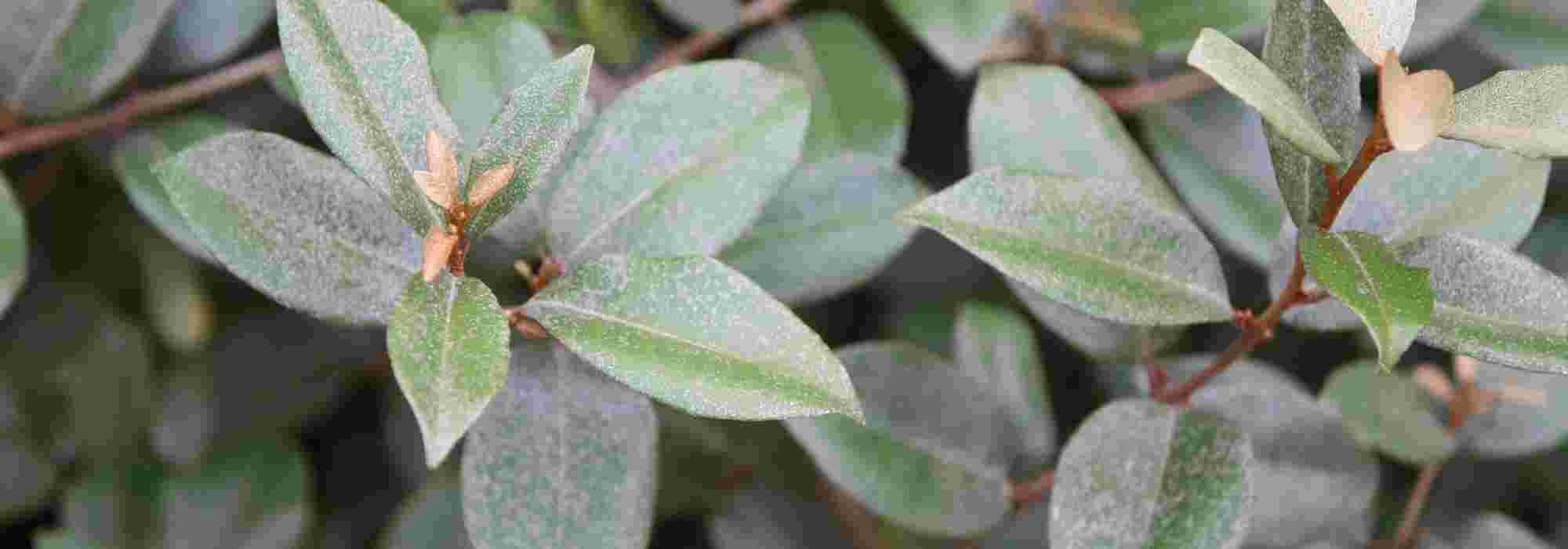
How to choose your Elaeagnus?
Our buyer's guide to help you make the right choice
Contents
Elaeagnus, Eleagnus or Oleaster is a bush highly valued for diversity of its plain or variegated foliage, prized for forming hedges and windbreaks and for its discreet but delightfully scented flowering followed by edible berries. It is an all‑terrain bush that tolerates cold, wind, heat and sea spray very well.
Distinguish evergreen Elaeagnus such as Elaeagnus ebbingei and its many cultivars that retain foliage in winter, and deciduous ones such as Elaeagnus angustifolia, equally interesting! All will bring a real source of golden or silvery light to your garden. You can choose a variety with variegated foliage, perfect to brighten slightly ternate areas of the garden, or a bush with soft silvery‑grey downy foliage. Choice of an Eleagnus can also be guided by pruning and by use.
Discover our tips to help choose right bush to suit your wishes and needs!
Evergreen or deciduous?
The genus includes 45 species as well as numerous cultivars among which we distinguish evergreen and deciduous Eleagnus.
The evergreen Eleagnus
Leading the way is Eleagnus ebbingei which declinates into about ten cultivars (‘Limelight’, ‘Gilt Edge’) and Elaeagnus pungens ‘Maculata’. They graciously keep their foliage in winter and flower throughout autumn in small scented cream-white bell-flowers followed by edible fruit. They are somewhat less hardy than deciduous varieties (-12 to -15°C in perfectly drained soil); better suited to mild climate. They are ideal by the sea because their foliage resists sea spray well. Evergreen Elaeagnus tolerate summer drought perfectly once established; the deciduous species are more resistant to cold, somewhat less so to drought.
Deciduous Eleagnus
They show absolutely remarkable resistance to cold (at least down to -20°C), therefore grow throughout France and mostly flower in May–June. In mild climate they are semi-evergreen or marcescent, that is, dead leaves remain attached to the twigs in winter. Among them are Elaeagnus angustifolia or “Russian olive” with thorny twigs, and Elaeagnus umbellata. Totally unaffected by pollution, they also make excellent hedges in sheltered urban gardens.
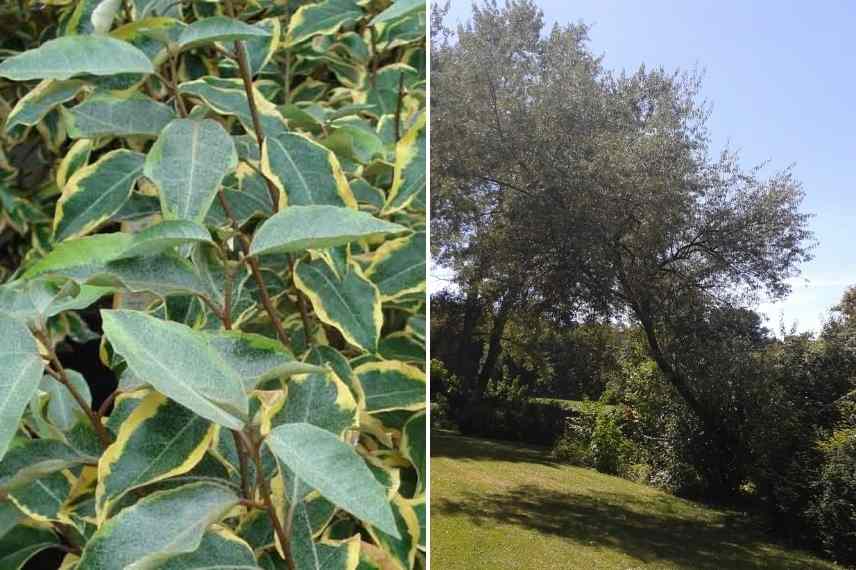
Eleagnus Ebbingei ‘Gilt Edge’ and Eleagnus angustifolia known as Russian olive, or tree of paradise, here as a majestic tree (Photo: G. David)
Depending on the colour of the foliage
Whether deciduous or evergreen, Elaeagnus offer a wide diversity of foliage whose colour varies according to species and varieties. They range from glossy dark green to silver-grey or blue-green, as well as variegated green tones splashed with particularly bright yellow.
Elaeagnus with unicoloured foliage
Among chalefs, unicoloured foliage is widespread; with its silver-grey or green sheens it comes alive at the slightest breeze and sparkles in sunlight. Among the most notable representatives:
- Elaeagnus x ebbingei or Chalef de Ebbing is the most widespread Elaeagnus. It is a hybrid between Elaeagnus macrophylla and pungens. It has produced around ten cultivars, notably with variegated foliage. Its foliage consists of elliptical leaves 6 to 10 cm long, dark green with metallic and silvery reflections. At maturity it reaches 2 to 4 m in height and width.
- Elaeagnus angustifolia or narrow-leaved chalef, also called “Russian olive”, forms a deciduous bush reaching over 5 m tall with a 4 m spread. It is particularly hardy (down to -40°C). It is distinguished from other species by its narrow leaves, 3 to 5 cm long, very silvery and satiny, resembling those of the olive. It displays a weeping habit with branches that arch slightly with time.
- ‘Elaeagnus commutata ‘Zempin’ or silver chalef quickly forms a deciduous bush up to 4 m tall. The ‘Zempin’ cultivar is a new form with thornless shoots and very beautiful lanceolate foliage: greyed and matte above, silvery and glossy beneath. It stands out from a distance thanks to the volume and brilliance of its foliage that plays with wind and light.
- Elaeagnus umbellata or umbelled chalef which loses its leaves in the cold season, has rapid growth combined with excellent hardiness. It quickly forms a large, dense bush reaching up to 4 m in height with a 3 m spread. Its foliage is sometimes semi-evergreen in mild climates. Leaves are narrow and undulate, more or less blue-green and matte above, silvery and satin-like beneath. Its autumn fruiting, made up of small edible red-currant berries, is particularly decorative. Rich in vitamins and antioxidants, these small fruits are prized for medicinal as well as culinary virtues, and can be eaten raw, or used in compote, jelly or jam.
- The Elaeagnus multiflora or Japanese goumi belongs to the tribe of Asian-origin chalefs, generally with deciduous foliage and edible fruit like its cousins umbellata and angustifolia. In 5 or 6 years it forms a ramified, bushy shrub as wide as tall, reaching up to 3 m in every direction. Leaves are ovate, 3 to 10 cm long with undulate margins. They are matt green above, silvery to orange-brown beneath. In addition to its lush growth, it produces small edible cherry-red drupes ripe in July–August.
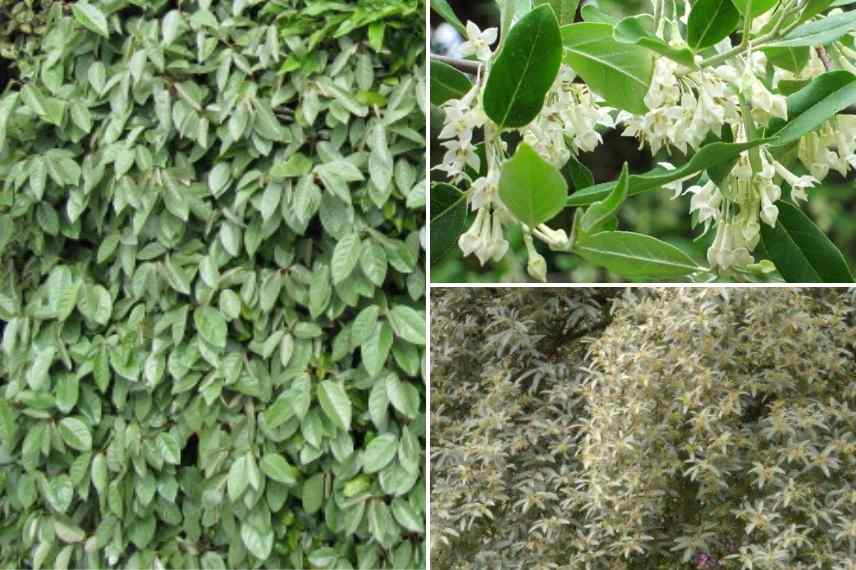
Eleagnus Ebbingei and Eleagnus umbellata top right, with green foliage, and Eleagnus commutata ‘Zempin’ with silvery leaves
Elaeagnus with variegated foliage
Chalef appears in various cultivars with variegated, margined or maculate foliage splashed with light or dark greens, cream or yellow. Variegated cultivars of E. x ebbingei, which are evergreen, are the most common. They are all highly ornamental throughout the year and particularly luminous. Ideal for brightening dull areas and dark corners of the garden.
- The Elaeagnus ebb. ‘Gilt Edge’ is notable for evergreen leaves dark green with metallic reflections edged with lemon-yellow, measuring 6 to 10 cm long. It is a very hardy cultivar of Chalef de Ebbing that can reach 2 m at maturity, forming a dense rounded clump year-round and very fragrant from September to October.
- The Elaeagnus ebbingei ‘Limelight’ is perhaps the most luminous of Ebbing chalefs! It displays leathery, glossy foliage, nicely maculate with bright yellow to cream-yellow at the centre on a pale green background, magnificent even in winter. Leaves measure 6 to 10 cm long. It is a medium-sized, well-branched bush, more vigorous than ‘Gilt Edge’. Its fragrant autumn flowering is followed by edible, decorative fruits resembling small olives of coppery and silvery colour.
- The Elaeagnus ebbingei ‘Eleador’ is a magnificent variety with evergreen foliage of vivid yellow to golden-yellow margined and splashed with various tones of green. It has particularly harmonious, bushy growth. Less hardy than its parent, it is suited to coastal gardens or dry gardens in regions with relatively mild winters.
- The Elaeagnus pungens ‘Maculata’ is a chalef notable for a globose, well-ramified habit. It forms a handsome bushy shrub with arching shoots 3–4 m tall, bearing splendid foliage with undulate margins, glossy green spotted with dark yellow at the centre. Leaves are evergreen and leathery, 4 to 10 cm long.
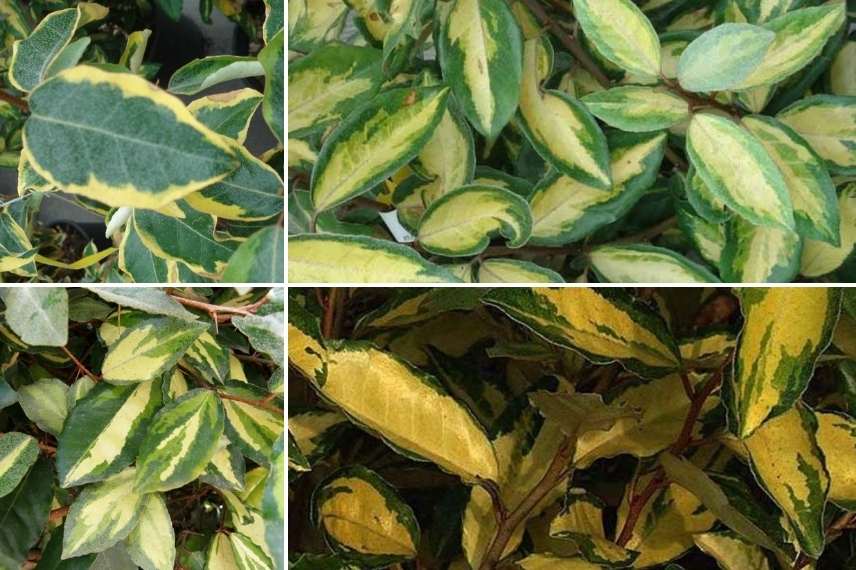
Top left: Eleagnus ebbingei ‘Gilt Edge’; bottom left: Eleagnus pungens ‘Maculata’; top right: Eleagnus ebbingei ‘Limelight’; bottom right: Eleagnus ebbingei ‘Eleador’
Discover other Elaeagnus - Oleaster
View all →Available in 3 sizes
Available in 4 sizes
Available in 2 sizes
Available in 3 sizes
Available in 3 sizes
Available in 1 sizes
Available in 1 sizes
Available in 1 sizes
Available in 2 sizes
Available in 1 sizes
Depending on use
Elaeagnus offer a fine diversity of sizes, ranging from hedging or border bushes not exceeding 3 m in height to small trees up to 10 m high and almost as wide, allowing use in a variety of situations. Some are notable for their large size, making them excellent as specimens.
For hedges
With rapid growth, all Elaeagnus are ideal for forming hedges quickly. Evergreen varieties such as Elaeagnus x ebbingei and Elaeagnus pungens ‘Maculata’ are excellent choices for informal or clipped hedges or for windbreaks composed of one or more species.
With its sharp thorns, Elaeagnus angustifolia also makes an excellent defensive hedge, while species umbellata and multiflora (goumi), with edible and decorative fruit, are great candidates for fruiting hedges and will delight curious gardeners and lovers of rare soft fruit.
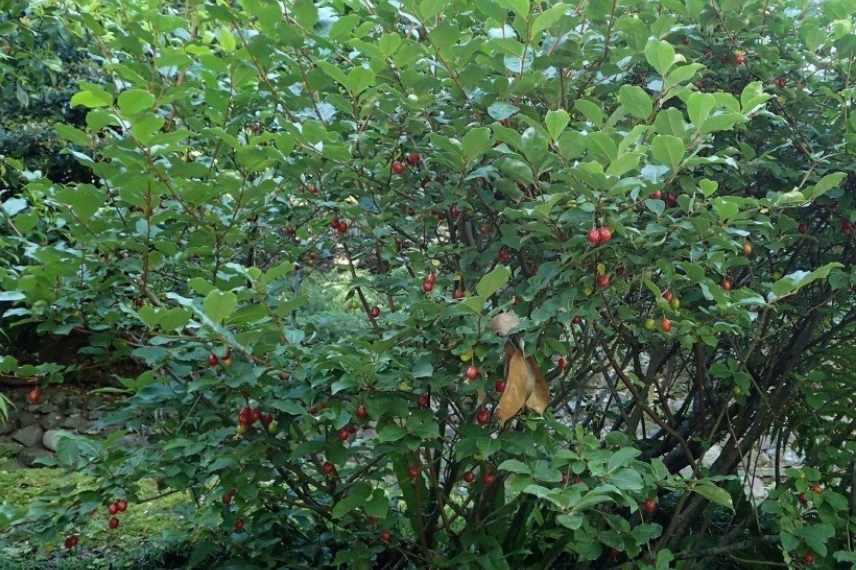
Elaeagnus multiflora, also called Japanese goumi
As a specimen
Some silverberries can easily stand alone, being naturally elegant and striking. Elaeagnus commutata ‘Zempin’ is an attractive selection noticeable from afar for its broad but supple habit, reaching up to 4 m in height with a 3 m spread. Variegated-leaved cultivars are well suited to planting as specimens at the heart of a border.
In a large container
Growing a silverberry in a pot is possible on a terrace or balcony to fully enjoy the remarkable scent of its small flowers. Provide a container deep enough, at least 30 cm deep and 40 cm in diameter. Choose evergreen varieties and very compact forms such as Elaeagnus ebbingei ‘Compacta’ and Elaeagnus ebbingei ‘Maryline Abrela’, two evergreen cultivars with a more moderate development than the typical species. They rarely exceed 2 m in height with a 1.5 m spread and stand out for their particularly dense, bushy habit, good branching and foliage strongly marked with light yellow and marginate with dark green.
→ Learn more with our advice sheet: How to grow an Elaeagnus in a pot?
For topiaries
Elaeagnus tolerates pruning very well, even severe pruning, and is therefore well suited to the art of topiary. Indeed, regular pruning is recommended for evergreen species because it stimulates the emergence of new shoots and helps maintain a well-filled, vigorous habit. Elaeagnus x ebbingei and Elaeagnus pungens can be pruned as desired.
Read also
Elaeagnus: when and how to prune?Find out more
- Also see our full guide: Elaeagnus: planting, pruning, growing
- Discover ideas for pairing Elaeagnus
- Subscribe!
- Contents
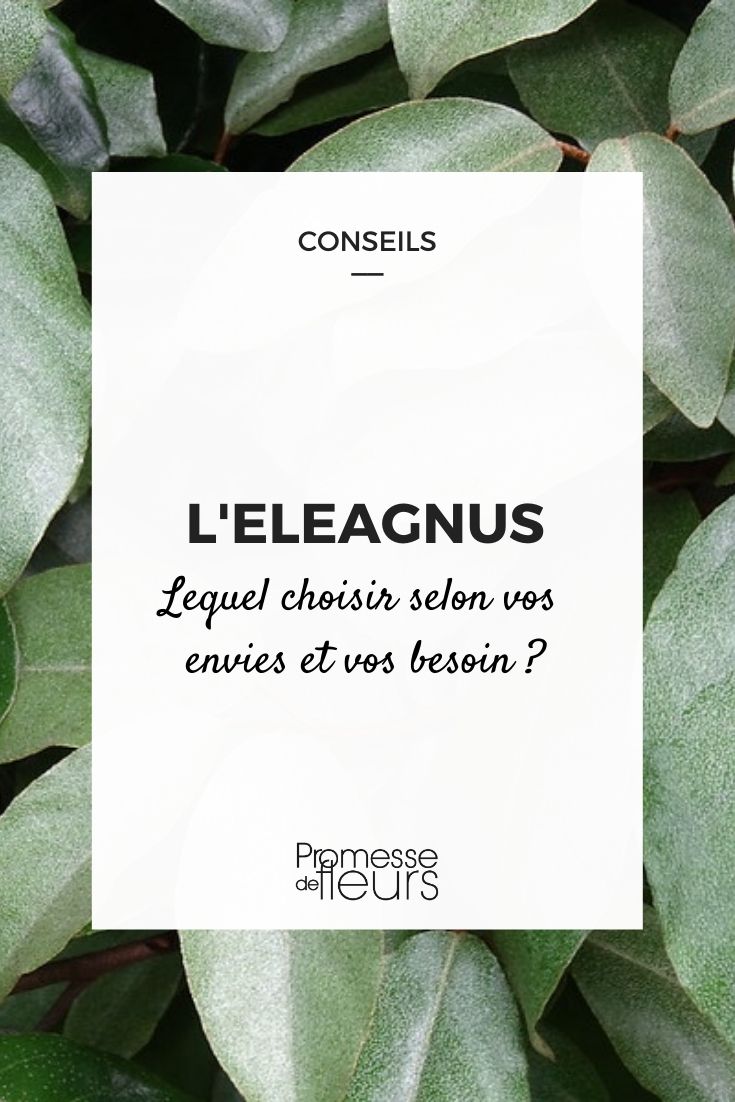































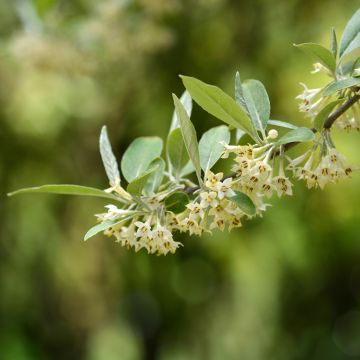
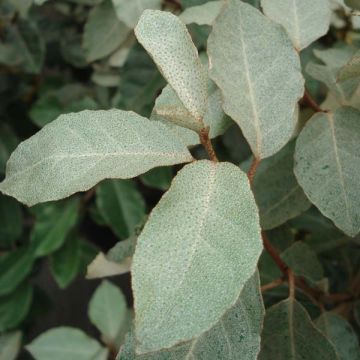
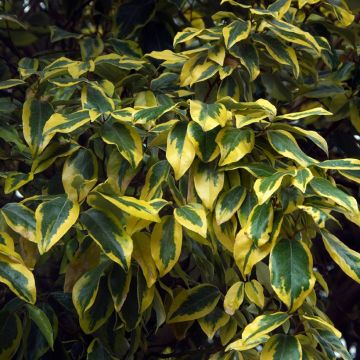
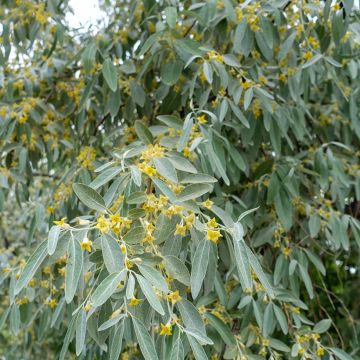
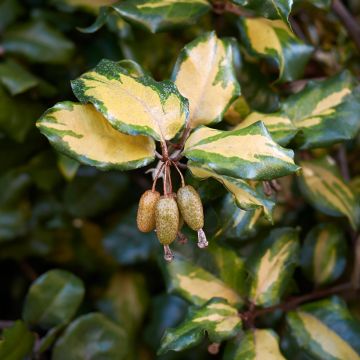


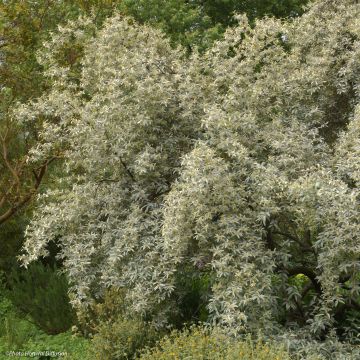

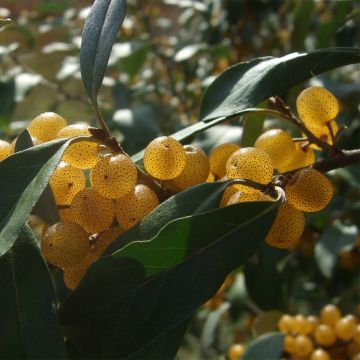
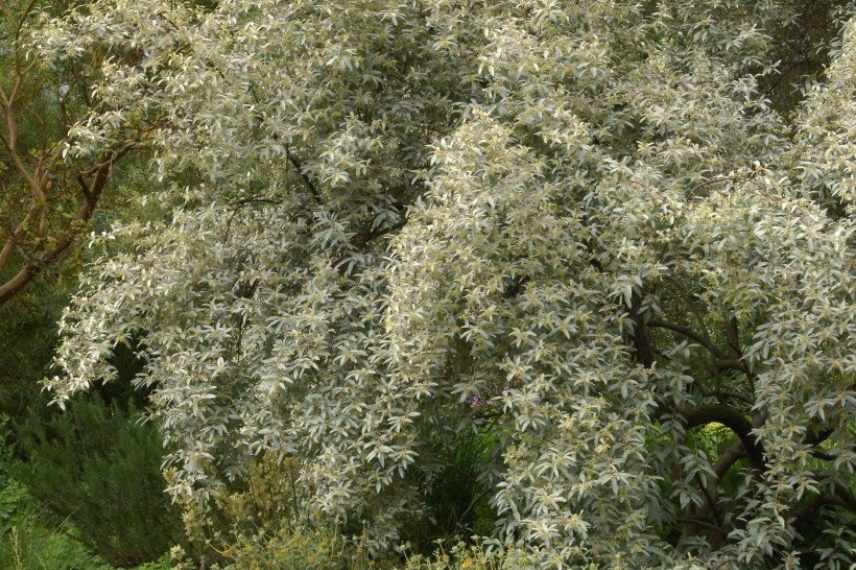
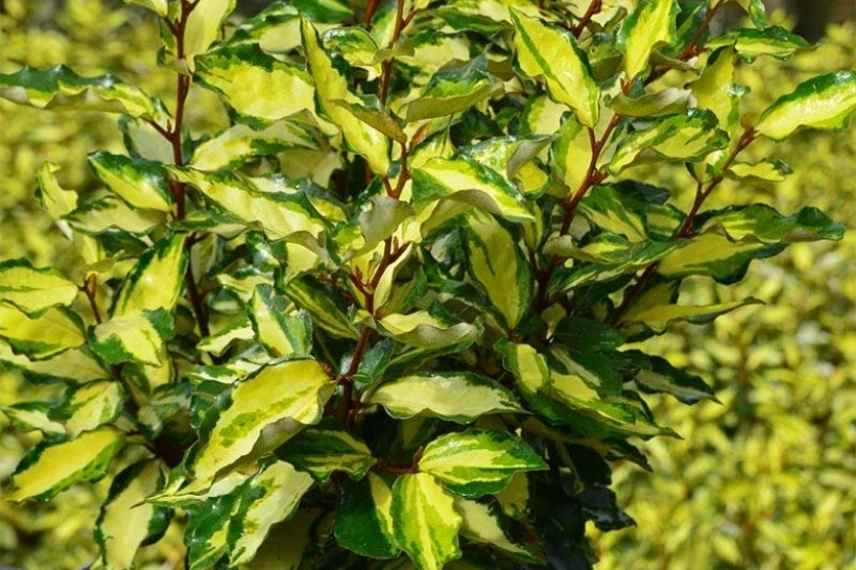
Comments